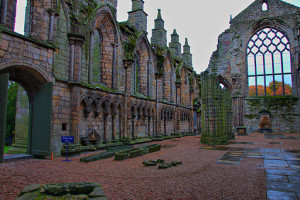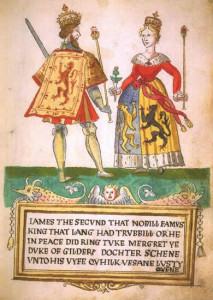Wars of the Roses and Foreign Personalities
A recent post in a Facebook history group got me thinking. We know so much about the main players of the Wars of the Roses, but what do we know about the foreign leaders with whom they interacted? Certainly these personalities influenced the ongoing tensions in England. This profile of James II is the first of several I hope to do over the next year.
James II of Scotland
James was born 16 October 1430 at Holyrood Abbey in Edinburgh. As the younger twin son of his parents, James I and Joan Beaufort, he would not have been king had his elder twin, Alexander, not died in infancy (1).
In 1437, James I was murdered in Perth. The assassins failed to kill the queen and she immediately sent word to Edinburgh to secure her son. Her quick thinking limited the power play of the conspirators of the plot, and soon they were in custody. Even though she was instrumental in bringing the conspirators to justice, Joan was soon shuffled aside as the new government was put in place.
Government of the Realm
Archibald, the fifth earl of Douglas, was put in place as basically a regent, and a governing council was established. After the death of Douglas, things began to fragment. First, Joan remarried to Sir James Stewart, and she and her new husband were imprisoned in Stirling Castle. In order for their release, the king had to be surrendered to the custody of Alexander Livingstone (2). Documentary evidence seems to back up the story of the king’s mother smuggling him out of Edinburgh Castle and taking him Stirling Castle. Soon afterwards, while out riding, he was taken back by Livingstone to Edinburgh (3). The next few years would be full of political maneuvering by the different factions.
Marriage and Power
Most of the king’s sisters had been advantageously married by this time. One of them, Mary, was sent to Veere to marry Wolfaert van Borselen (4). Years later, van Borselen would aid Richard, Duke of Gloucester, when he landed in Veere. For the Scots, this marriage meant better trade with the Low Countries.
The king’s marriage to Mary of Gueldres (Guelders), a niece of Duke Philip of Burgundy, was to prove a turning point in the power struggles in Scotland. Soon after James married, he began wielding his power and the structure of the government shifted. The Livingstones were arrested, and others, such as Lord Chricton and the Earl of Douglas came into the king’s favor. The eventual murder of the Earl of Douglas by the king’s men would eventually lead to political upheaval that would take years to quell.
James and England
There is evidence that James wanted to take advantage of England’s weakness. He had already led two assaults on Berwick and a raid on Northumberland (5). The Scottish king had been wily – he was negotiating with both the Lancastrians and the Yorks, hoping to exploit divisions between these two groups to his advantage. In the summer of 1460, James decided to lead a siege on the English at Roxburgh Castle. Unfortunately for James, a cannon exploded as he stood nearby and inflicted a wound which led to his death. His untimely death would put an end to plans for his army to advance south (6).
Afterthoughts
The struggle between the Douglas family and James II is fascinating. If you are interested in reading more about the Douglas family, there are many books from which to choose. Oliver Thomson’s book, From The Bloody Heart: The Stewarts and The Douglases, examines the families over the period of 400 years. The Black Douglases: War and Lordship in Medieval Scotland 1300-1455 by Michael Brown discusses the rise of the family and the eventual destruction of the Douglas earls. There are many other books about these two families available.
References:
1. Borthwick, Alan. “James II.” Oxford Dictionary of National Biography. http://www.oxforddnb.com/view/article/14588?docPos=1 (accessed 2 January 2015).
2. Ibid
3. Oram, Richard. The Kings and Queens of Scotland. (Stroud, 2006)
4. Ibid.
5. Borthwick.
6. Ibid.
Which foreign personality interests you the most? Comment below.



